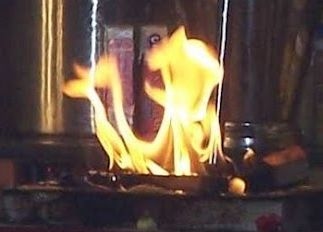The goddess of speech, vāg devatā, is worshipped by all upāsakas. In the beginning, this is often implicit, or consists of a simple vandana to vāg devī or saraswatī. At a later time, this is often made explicit, in the form of the bahir mātr̥kā nyāsa and antar mātr̥kā nyāsa, i.e. when vāg devī and the alphabet are explicitly worshipped externally and internally respectively.
The dhyāna śloka for vāg devatā (as part of the bahir mātr̥kā nyāsa) follows:
पञ्चाषल्लिपिभिर्विभक्तमुखदोःपन्मध्यवक्षस्थलाम्
भास्वद्मौलिनिबद्धचन्द्रशकलामापीनतुङ्गस्थलीम् ।
मुद्रामक्षगुणं सुधाढ्यकलशं विद्यां च हस्ताम्बुजैः
बिभ्राणां विशदप्रभां त्रिनयनां वाग्देवतामाश्रजे ॥
(शारदातिलकतन्त्रम् ६.४)
I take refuge in that goddess of speech, who is herself the 50 letters of the alphabet divided to form her mouth, arms, feet, waist and chest. She sports a sliver of the shining [dvitīyā] moon on her crown and has full breasts. She holds the mudrā, japa māla, kalaśa of nectar and vidyā in her lotus hands. She is bright hued and has three eyes.
The antar mātr̥kā nyāsa describes the division of the 50 letters amongst the various chakras in the kuṇḍalinī. One simple description is given in the following śloka:
आधारे लिङ्गनाभौ हृदयसरसिजे तालुमध्ये ललाटे
द्वे पत्रे षोडशारे द्विदशदशदले द्वादशार्धे चतुष्के ।
वासान्ते बालमध्ये डफकठसहिते कण्ठमूले स्वराणाम्
हं क्षं तत्त्वार्थयुक्तं सकलदलयुतं वर्णरूपं नमामि ॥
(श्रीमहात्रिपुरसुन्दरीपूजाकल्पः)
This is a memory-aid that serves as a reminder to those who have already learnt the details. The six chakras from the bottom up are located at the base of the spine (ādhāra), generative organs (liṅga), navel (nābhi), heart (hr̥daya), palate (tālu) and forehead (lalāṭa). From top to bottom, they have 2, 16, 12, 10, 6 and 4 petals. From the bottom up the following letter sequences are placed on the petals: va - sa, ba - la, ḍa - pha, ka - ṭha, the vowels, haṁ and kṣaṁ. This is better described by the following table:
| ājñā | forehead | 2 | haṁ, kṣaṁ |
| viśuddhi | palate | 16 | vowels |
| anāhata | heart | 12 | ka - ṭha |
| maṇipūraka | navel | 10 | ḍa - pha |
| svādhiṣṭhāna | generative organs | 6 | ba - la |
| mūlādhāra | base | 4 | va - sa |
Each of these chakras, along with the adhidevatās are then worshipped separately. One śaiva tradition uses the following ślokas in that worship (there are minor differences from the table above).
वशषसदलयुक्ते सम्यगाधारपद्मे तरुणमरुणगात्रं वारणास्यं गणेशम् ।
अभयवरदहस्तं चारुपाशाङ्कुशोद्यत्करयुगलमनन्यं चिन्तयेद्विघराजम् ॥
In the ādhāra padma with the letters va, śa, ṣa and sa, meditate upon the lord of obstacles, gaṇeśa, who is youthful and reddish, with the face of an elephant. He sports the abhaya and varada mudrās in his hands along with the noose and goad.
बभमयरलवर्णैः पत्रषट्के सरोजे सुखतरमुपविष्टं हंसवाहं सुरेढ्यम् ।
अभयवरदहस्तं कुण्डिकामक्षमालां निगमवदनपद्मं चिन्तयेद्विश्वयोनिम् ॥
In the svādiṣṭhāna with the letters ba, bha, ma, ya, ra and va in the six petals, meditate upon the source of creation (brahmā), seated comfortably upon the swan, and worshipped by the devas. His vedas themselves are his face, and his hands show the abhaya and varada mudrās along with a water-pot and rosary.
ढाद्यैः फान्तगतैः प्रकल्पितदले पद्मे निविष्टं हरिम्
मार्ताण्डद्युतिमादिपूरुषमजं नारायणं सर्वगम् ।
मूर्तामूर्तमनेकमूर्तिममलं पीताम्बरं कौस्तुभ-
श्रीवत्साङ्कितमब्धिजासहचरं ध्यायेज्जगद्मोहनम् ॥
In the maṇipūraka with the letters ḍha to pha, contemplate upon hari who is seated there with the splendour of the sun. He is the everpresent first being known as nārāyaṇa. He is manifest, unmanifest and is present in various forms, is clothed in yellow, and is marked with the kaustubha gem and śrīvatsa. He always sports with lakṣmī who was born out of the ocean and enchants the world.
काद्यैष्ठान्तगतैः प्रकल्पितदले पङ्केरुहे पार्वती-
कान्तं पूर्णशशाङ्ककोटिकिरणप्रख्यं कपर्दोज्ज्वलम् ।
शान्तं टङ्कमृगाभयेष्टफलं भोगीन्द्रभास्वत्कटिम्
ध्यायेद्रुद्रमनादिमध्यनिधनं हृत्पुण्डरीकस्थितम् ॥
In the lotus of the heart with the letters ka to ṭha, contemplate upon pārvati’s consort rudra. His matted locks shine with the lustre of thousand full moons. He is peaceful and holds the axe, deer, abhaya and varada mudras. The king of serpents shines on his waist. He has no beginning, middle or end.
बिन्दुस्थानगतं महेश्वरमजं शान्तं तुषारप्रभम्
व्याप्ताशेषचराचरं गुणगणैः सर्वज्ञताद्यैर्वृतम् ।
मूर्तामूर्तमनेकमूर्तिरनघं ज्योतिःप्रदीपोज्ज्वलम्
साक्षात् षोडशपत्रयुक्तकमले ध्येयं परं चिन्तयेत् ॥
In the bindu, contemplate upon maheśvara who is peaceful with white lustre in the sixteen-petalled lotus. He permeates the entire worship of moving and fixed, and is surrounded by all good beings like those who are all-knowing. He is unmanifest, manifest, and is present in various forms. He is devoid of defects, and shines with radiance.
ळक्षाभ्यां परिवृत्तपत्रकमले दिव्ये जगत्कारणम्
विश्वव्यापिणमादिदेवममलज्ञानक्रियेच्छातनुम् ।
अध्वव्यापिमनोन्मनीसहचरं भावप्रदीपाङ्कुरम्
प्रत्यक्षाक्षरविग्रहं तमनिशं ध्यायेत् सदेशं शिवम् ॥
Contemplate incessently upon sadāśiva in the divine lotus with the letters ḷa and kṣa. He is the cause of the world, and permeates it. He is the pure first deva whose body is the threefold icchā, jñāna and kriyā śaktis. He accompanies the manonmamī śakti who permeates time. He is the bud of existence and knowledge. His vigraha is imperishable.

